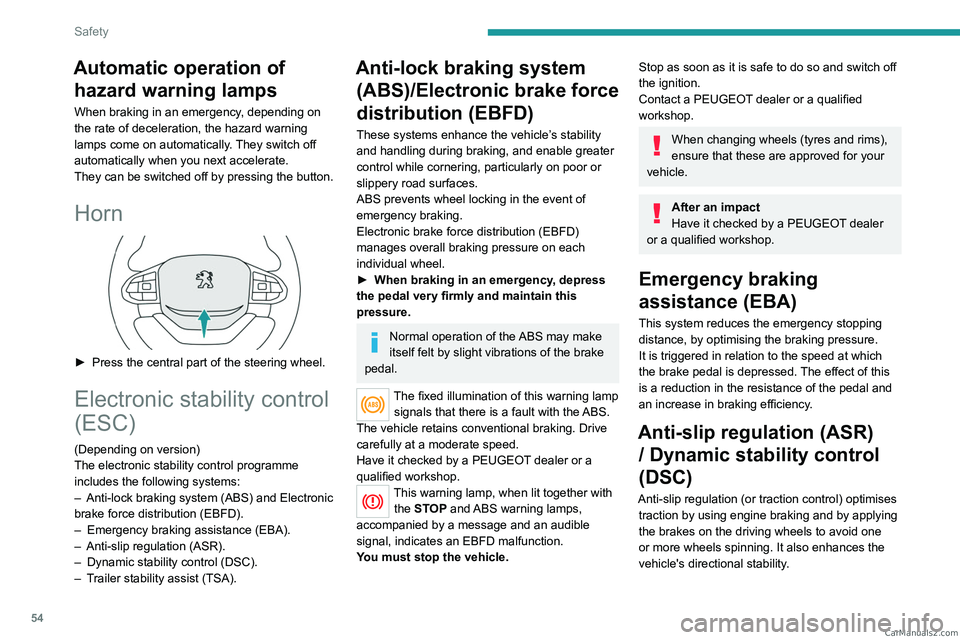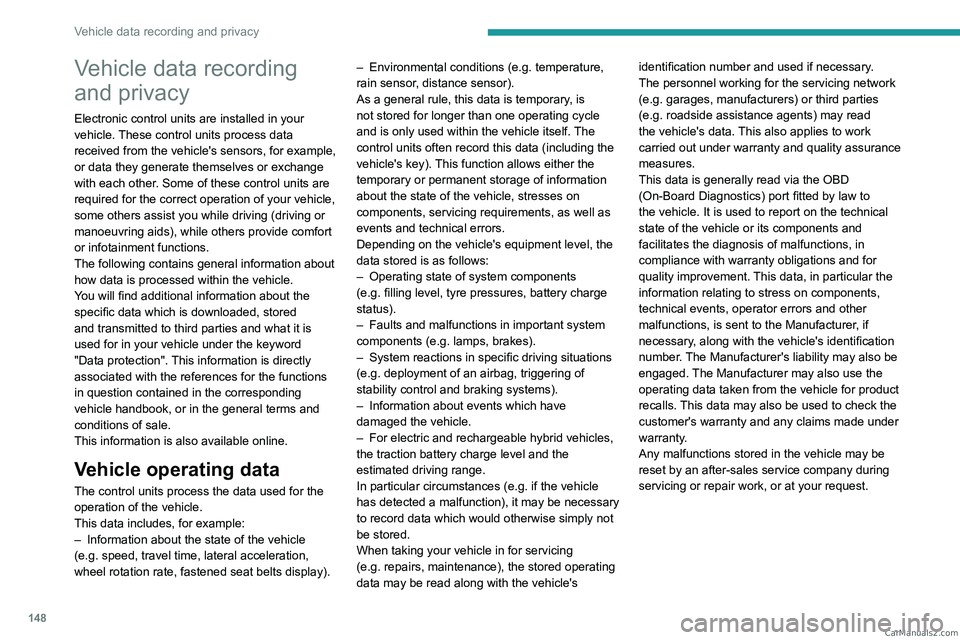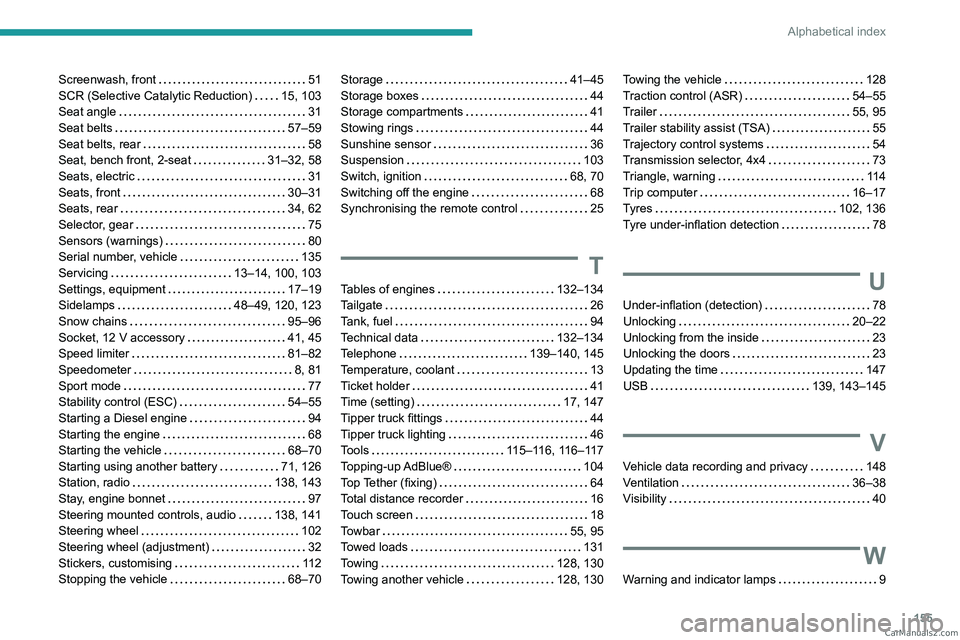traction control PEUGEOT LANDTREK 2023 Owners Manual
[x] Cancel search | Manufacturer: PEUGEOT, Model Year: 2023, Model line: LANDTREK, Model: PEUGEOT LANDTREK 2023Pages: 164, PDF Size: 6.1 MB
Page 56 of 164

54
Safety
Automatic operation of hazard warning lamps
When braking in an emergency, depending on
the rate of deceleration, the hazard warning
lamps come on automatically. They switch off
automatically when you next accelerate.
They can be switched off by pressing the button.
Horn
► Press the central part of the steering wheel.
Electronic stability control
(ESC)
(Depending on version)
The electronic stability control programme
includes the following systems:
–
Anti-lock braking system (ABS) and Electronic
brake force distribution (EBFD).
–
Emergency braking assistance (EBA).
–
Anti-slip regulation (ASR).
–
Dynamic stability control (DSC).
–
T
railer stability assist (TSA).
Anti-lock braking system (ABS)/Electronic brake force
distribution (EBFD)
These systems enhance the vehicle’s stability
and handling during braking, and enable greater
control while cornering, particularly on poor or
slippery road surfaces.
ABS prevents wheel locking in the event of
emergency braking.
Electronic brake force distribution (EBFD)
manages overall braking pressure on each
individual wheel.
►
When braking in an emergency
, depress
the pedal very firmly and maintain this
pressure.
Normal operation of the ABS may make
itself felt by slight vibrations of the brake
pedal.
The fixed illumination of this warning lamp signals that there is a fault with the ABS.
The vehicle retains conventional braking. Drive
carefully at a moderate speed.
Have it checked by a PEUGEOT dealer or a
qualified workshop.
This warning lamp, when lit together with the STOP and ABS warning lamps,
accompanied by a message and an audible
signal, indicates an EBFD malfunction.
You must stop the vehicle.
Stop as soon as it is safe to do so and switch off
the ignition.
Contact a PEUGEOT dealer or a qualified
workshop.
When changing wheels (tyres and rims),
ensure that these are approved for your
vehicle.
After an impact
Have it checked by a PEUGEOT dealer
or a qualified workshop.
Emergency braking
assistance (EBA)
This system reduces the emergency stopping
distance, by optimising the braking pressure.
It is triggered in relation to the speed at which
the brake pedal is depressed. The effect of this
is a reduction in the resistance of the pedal and
an increase in braking efficiency.
Anti-slip regulation (ASR) / Dynamic stability control
(DSC)
Anti-slip regulation (or traction control) optimises
traction by using engine braking and by applying
the brakes on the driving wheels to avoid one
or more wheels spinning. It also enhances the
vehicle's directional stability. CarM an uals 2 .c o m
Page 150 of 164

148
Vehicle data recording and privacy
Vehicle data recording
and privacy
Electronic control units are installed in your
vehicle. These control units process data
received from the vehicle's sensors, for example,
or data they generate themselves or exchange
with each other. Some of these control units are
required for the correct operation of your vehicle,
some others assist you while driving (driving or
manoeuvring aids), while others provide comfort
or infotainment functions.
The following contains general information about
how data is processed within the vehicle.
You will find additional information about the
specific data which is downloaded, stored
and transmitted to third parties and what it is
used for in your vehicle under the keyword
"Data protection". This information is directly
associated with the references for the functions
in question contained in the corresponding
vehicle handbook, or in the general terms and
conditions of sale.
This information is also available online.
Vehicle operating data
The control units process the data used for the
operation of the vehicle.
This data includes, for example:
–
Information about the state of the vehicle
(e.g.
speed, travel time, lateral acceleration,
wheel rotation rate, fastened seat belts display). –
Environmental conditions (e.g.
temperature,
rain sensor, distance sensor).
As a general rule, this data is temporary, is
not stored for longer than one operating cycle
and is only used within the vehicle itself. The
control units often record this data (including the
vehicle's key). This function allows either the
temporary or permanent storage of information
about the state of the vehicle, stresses on
components, servicing requirements, as well as
events and technical errors.
Depending on the vehicle's equipment level, the
data stored is as follows:
–
Operating state of system components
(e.g.
filling level, tyre pressures, battery charge
status).
–
Faults and malfunctions in important system
components (e.g.
lamps, brakes).
–
System reactions in specific driving situations
(e.g.
deployment of an airbag, triggering of
stability control and braking systems).
–
Information about events which have
damaged the vehicle.
–
For electric and rechargeable hybrid vehicles,
the traction battery charge level and the
estimated driving range.
In particular circumstances (e.g.
if the vehicle
has detected a malfunction), it may be necessary
to record data which would otherwise simply not
be stored.
When taking your vehicle in for servicing
(e.g.
repairs, maintenance), the stored operating
data may be read along with the vehicle's identification number and used if necessary.
The personnel working for the servicing network
(e.g.
garages, manufacturers) or third parties
(e.g. roadside assistance agents) may read
the vehicle's data. This also applies to work
carried out under warranty and quality assurance
measures.
This data is generally read via the OBD
(On-Board Diagnostics) port fitted by law to
the vehicle. It is used to report on the technical
state of the vehicle or its components and
facilitates the diagnosis of malfunctions, in
compliance with warranty obligations and for
quality improvement. This data, in particular the
information relating to stress on components,
technical events, operator errors and other
malfunctions, is sent to the Manufacturer, if
necessary, along with the vehicle's identification
number. The Manufacturer's liability may also be
engaged. The Manufacturer may also use the
operating data taken from the vehicle for product
recalls. This data may also be used to check the
customer's warranty and any claims made under
warranty.
Any malfunctions stored in the vehicle may be
reset by an after-sales service company during
servicing or repair work, or at your request. CarM an uals 2 .c o m
Page 157 of 164

155
Alphabetical index
Screenwash, front 51
SCR (Selective Catalytic Reduction)
15, 103
Seat angle
31
Seat belts
57–59
Seat belts, rear
58
Seat, bench front, 2-seat
31–32, 58
Seats, electric
31
Seats, front
30–31
Seats, rear
34, 62
Selector, gear
75
Sensors (warnings)
80
Serial number, vehicle
135
Servicing
13–14, 100, 103
Settings, equipment
17–19
Sidelamps
48–49, 120, 123
Snow chains
95–96
Socket, 12 V accessory
41, 45
Speed limiter
81–82
Speedometer
8, 81
Sport mode
77
Stability control (ESC)
54–55
Starting a Diesel engine
94
Starting the engine
68
Starting the vehicle
68–70
Starting using another battery
71, 126
Station, radio
138, 143
Stay, engine bonnet
97
Steering mounted controls, audio
138, 141
Steering wheel
102
Steering wheel (adjustment)
32
Stickers, customising
11 2
Stopping the vehicle
68–70Storage 41–45
Storage boxes
44
Storage compartments
41
Stowing rings
44
Sunshine sensor
36
Suspension
103
Switch, ignition
68, 70
Switching off the engine
68
Synchronising the remote control
25
T
Tables of engines 132–134
Tailgate
26
Tank, fuel
94
Technical data
132–134
Telephone
139–140, 145
Temperature, coolant
13
Ticket holder
41
Time (setting)
17, 147
Tipper truck fittings
44
Tipper truck lighting
46
Tools
115–116, 116–117
Topping-up AdBlue®
104
Top Tether (fixing)
64
Total distance recorder
16
Touch screen
18
Towbar
55, 95
Towed loads
131
Towing
128, 130
Towing another vehicle
128, 130
Towing the vehicle 128
Traction control (ASR)
54–55
Trailer
55, 95
Trailer stability assist (TSA)
55
Trajectory control systems
54
Transmission selector, 4x4
73
Triangle, warning
11 4
Trip computer
16–17
Tyres
102, 136
Tyre under-inflation detection
78
U
Under-inflation (detection) 78
Unlocking
20–22
Unlocking from the inside
23
Unlocking the doors
23
Updating the time
147
USB
139, 143–145
V
Vehicle data recording and privacy 148
Ventilation
36–38
Visibility
40
W
Warning and indicator lamps 9 CarM an uals 2 .c o m